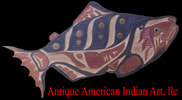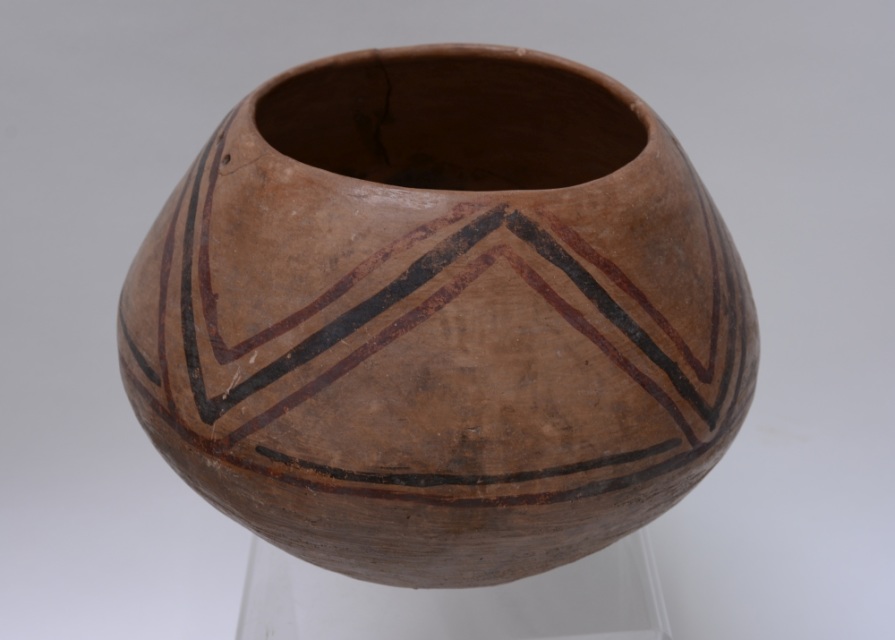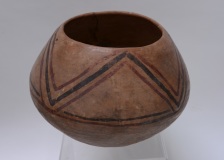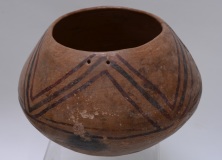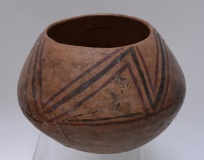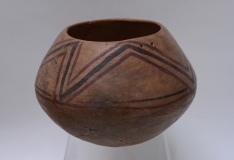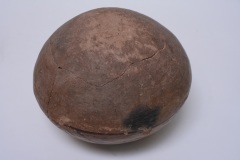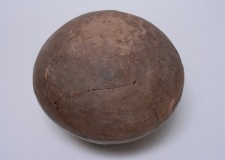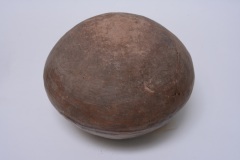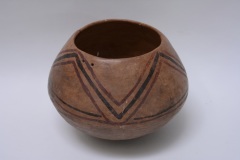- The Artifact Collection Gallery Catalog
- >
- Pottery
- >
- Precolumbian Pottery - Artifacts - Meso-South America
- >
- 160901-06 Prehistoric Indian - pre Columbian Casas Grande Pottery Jar
160901-06 Prehistoric Indian - pre Columbian Casas Grande Pottery Jar
SKU:
160901-06
$695.00
$695.00
Unavailable
per item
6 1/2" x 9"
Thin walled, beautiful form polychrome that broke with just one section falling out which was glued back in. With period drill holes near rim. Strong paint and beautiful form. All original, no overpaint.
pre-Columbian jar dating to circa 1250-1660 AD. It is classified as Ramos Polychrome, a type associated with the Casas Grandes’ culture centered at Paquimé in what is now Chihuahua, Mexico.
Casas Grandes (Spanish for Great Houses; also known as Paquimé) is a prehistoric archaeological site in the northern Mexican state of Chihuahua. Construction of the site is attributed to the Mogollon culture. Casas Grandes has been designated a UNESCO World Heritage Site and is under the purview of INAH.
Casas Grandes is one of the largest and most complex Mogollon culture sites in the region. Settlement began after 1130 CE, and would see the larger buildings developed into multi-storied dwellings after 1350 CE. The community was abandoned approximately 1450 CE. Casas Grandes is regarded as one of the most significant Mogollon archaeological zones in the northwestern Mexico region, linking it to other sites in Arizona and New Mexico in the United States, and exhibiting the expanse of the Mogollon sphere of influence.
Casas Grandes complex is located in a wide, fertile valley on the Casas Grandes or San Miguel River, 35 miles (56 km) south of Janos and 150 miles (240 km) northwest of the state capital, the city of Chihuahua. The settlement relied on irrigation to support its agriculture.
The archaeological zone is contained within the eponymous modern municipio (municipality) of Casas Grandes. The valley and region have been inhabited by indigenous groups for thousands of years.
Between CE 1130 and 1300, the area's inhabitants began to congregate in small settlements in this wide fertile valley. The largest identified settlement is known today as Paquimé or Casas Grandes. It began as a group of 20 or more house clusters, each with a plaza and enclosing wall. These single-story adobe dwellings shared a common water system. Evidence shows that Paquimé had a complex water control system that included underground drain systems, reservoirs, channels for water to get to the homes, and a sewage system.
After being burned about 1340, Casas Grandes was rebuilt with multi-story apartment buildings to replace the small buildings. Casas Grandes consisted of about 2,000 adjoining rooms built of adobe, I-shaped Mesoamerican ballcourts, stone-faced platforms, effigy mounds, and a market area. About 350 other, smaller settlement sites have been found in the Casas Grandes area, some as far as 70 kilometers (39 miles) away. Archaeologists believe that the area directly controlled by Casas Grandes was relatively small, extending out about 30 kilometres (19 mi) from the city. The population may have been about 2,500 in Casas Grandes with perhaps 10,000 people living within its area of control.
Specialized craft activities included the production of copper bells and ornaments, extensive pottery, and beads from marine molluscs. These crafts were probably distributed by an extensive trading network. Casas Grandes pottery has a white or reddish surface, with ornamentation in blue, red, brown, or black. It is sometimes considered of better manufacture than the modern pottery in the area. Effigy bowls and vessels were often formed in the shape of a painted human figure. Casas Grandes pottery was traded among prehistoric peoples as far north as present-day New Mexico and Arizona and throughout northern Mexico.
The archaeologist Stephen Lekson has noted that Paquimé is aligned on roughly the same longitudinal axis as Chaco Canyon and Aztec Ruins, with an error of only a few miles. Chaco reached its cultural peak first, then Aztec and Paquimé. The similarities among these sites may indicate that their ruling elites also had a ceremonial connection. Lekson proposed that ruling elites, once removed from their prior positions at Chaco, re-established their hegemony over the area at Aztec and later Paquime. This idea, though, remains controversial and is not as widely accepted as often reported (cf. Lekson 2009). It has been proposed, and more widely accepted, that the origins of Paquime can be found in its connection with the Mogollon culture.
Thin walled, beautiful form polychrome that broke with just one section falling out which was glued back in. With period drill holes near rim. Strong paint and beautiful form. All original, no overpaint.
pre-Columbian jar dating to circa 1250-1660 AD. It is classified as Ramos Polychrome, a type associated with the Casas Grandes’ culture centered at Paquimé in what is now Chihuahua, Mexico.
Casas Grandes (Spanish for Great Houses; also known as Paquimé) is a prehistoric archaeological site in the northern Mexican state of Chihuahua. Construction of the site is attributed to the Mogollon culture. Casas Grandes has been designated a UNESCO World Heritage Site and is under the purview of INAH.
Casas Grandes is one of the largest and most complex Mogollon culture sites in the region. Settlement began after 1130 CE, and would see the larger buildings developed into multi-storied dwellings after 1350 CE. The community was abandoned approximately 1450 CE. Casas Grandes is regarded as one of the most significant Mogollon archaeological zones in the northwestern Mexico region, linking it to other sites in Arizona and New Mexico in the United States, and exhibiting the expanse of the Mogollon sphere of influence.
Casas Grandes complex is located in a wide, fertile valley on the Casas Grandes or San Miguel River, 35 miles (56 km) south of Janos and 150 miles (240 km) northwest of the state capital, the city of Chihuahua. The settlement relied on irrigation to support its agriculture.
The archaeological zone is contained within the eponymous modern municipio (municipality) of Casas Grandes. The valley and region have been inhabited by indigenous groups for thousands of years.
Between CE 1130 and 1300, the area's inhabitants began to congregate in small settlements in this wide fertile valley. The largest identified settlement is known today as Paquimé or Casas Grandes. It began as a group of 20 or more house clusters, each with a plaza and enclosing wall. These single-story adobe dwellings shared a common water system. Evidence shows that Paquimé had a complex water control system that included underground drain systems, reservoirs, channels for water to get to the homes, and a sewage system.
After being burned about 1340, Casas Grandes was rebuilt with multi-story apartment buildings to replace the small buildings. Casas Grandes consisted of about 2,000 adjoining rooms built of adobe, I-shaped Mesoamerican ballcourts, stone-faced platforms, effigy mounds, and a market area. About 350 other, smaller settlement sites have been found in the Casas Grandes area, some as far as 70 kilometers (39 miles) away. Archaeologists believe that the area directly controlled by Casas Grandes was relatively small, extending out about 30 kilometres (19 mi) from the city. The population may have been about 2,500 in Casas Grandes with perhaps 10,000 people living within its area of control.
Specialized craft activities included the production of copper bells and ornaments, extensive pottery, and beads from marine molluscs. These crafts were probably distributed by an extensive trading network. Casas Grandes pottery has a white or reddish surface, with ornamentation in blue, red, brown, or black. It is sometimes considered of better manufacture than the modern pottery in the area. Effigy bowls and vessels were often formed in the shape of a painted human figure. Casas Grandes pottery was traded among prehistoric peoples as far north as present-day New Mexico and Arizona and throughout northern Mexico.
The archaeologist Stephen Lekson has noted that Paquimé is aligned on roughly the same longitudinal axis as Chaco Canyon and Aztec Ruins, with an error of only a few miles. Chaco reached its cultural peak first, then Aztec and Paquimé. The similarities among these sites may indicate that their ruling elites also had a ceremonial connection. Lekson proposed that ruling elites, once removed from their prior positions at Chaco, re-established their hegemony over the area at Aztec and later Paquime. This idea, though, remains controversial and is not as widely accepted as often reported (cf. Lekson 2009). It has been proposed, and more widely accepted, that the origins of Paquime can be found in its connection with the Mogollon culture.
1 available
